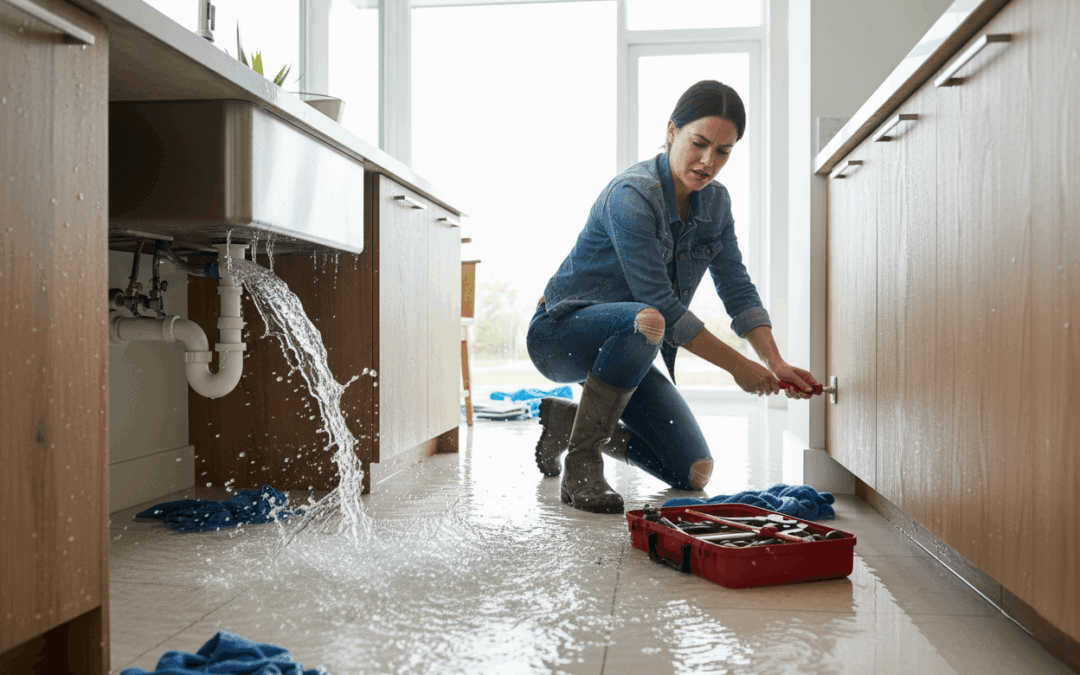When a pipe bursts in your home, panic is a natural response—especially when it’s 2am and water is rapidly flooding your floors. But knowing the right steps to take can minimize water damage, protect your belongings, and potentially save you thousands in repairs.
Immediate Steps When Your Pipe Bursts
1. Turn Off the Electricity Immediately
Safety comes first. Before stepping into any standing water, shut off the electrical power to affected areas. Water and electricity create a deadly combination that can result in electrocution.
If your circuit breaker is in a flooded area, do not attempt to reach it. Instead:
- Use a flashlight (never candles) if it’s dark
- Call an electrician or emergency services if you cannot safely access the breaker
- Stay out of rooms with standing water until power is confirmed off
2. Locate and Shut Off Your Water Supply
Stop the water at its source to prevent further flooding:
Find the specific shut-off valve for the leaking pipe if you can locate it quickly. However, the main water shut-off valve is your best option during an emergency. This valve is typically:
- Located near your water meter
- Usually found outside your home or in the basement
- Requires a water meter key or wrench to operate
Pro tip: Know where your main shut-off valve is before an emergency happens. Mark it clearly and keep the necessary tools nearby.
3. Move Furniture and Valuables to Safety
Once the water is stopped and it’s safe to enter:
- Remove furniture from standing water
- Lift electronics and appliances off the floor
- Relocate important documents, photos, and valuables to dry areas
- Roll up rugs and carpets to prevent further saturation
Time is critical—water damage worsens with every passing minute, and mold can begin developing within 24-48 hours.
4. Contact Your Insurance Company
Document everything before cleanup begins:
- Take photos and videos of all water damage
- Make a list of damaged items
- Keep receipts for emergency repairs
- Call your homeowner’s insurance agent as soon as possible
Most insurance policies cover sudden pipe bursts, but coverage varies. Your agent will guide you through the claims process and may send an adjuster to assess the damage.
When to Call Emergency Water Restoration Services
Some situations require professional help immediately:
- Extensive flooding affecting multiple rooms
- Contaminated water (from sewage or external sources)
- Structural damage to walls, ceilings, or floors
- After-hours emergencies when you need immediate response
Professional water damage restoration companies Blue Chip Restoration provide 24/7 emergency response services. We have industrial-grade equipment to extract water, dry your home thoroughly, and prevent mold growth.
Preventing Future Pipe Bursts
Common causes of burst pipes include:
- Freezing temperatures are causing ice expansion
- Corroded or aging pipes
- High water pressure
- Clogs are creating excessive pressure
- Foundation shifts or settling
Prevention tips:
- Insulate pipes in unheated areas
- Keep your home heated during winter
- Have your plumbing system inspected regularly
- Know the age of your pipes
- Install a water pressure regulator if needed
Frequently Asked Questions
How quickly can water damage spread in a home? Water can spread throughout a room in minutes and seep into walls, floors, and subflooring within hours. That’s why immediate action is crucial.
Should I try to clean up flood water myself? Small amounts of clean water from a burst pipe can be handled DIY, but significant flooding, contaminated water, or damage affecting multiple rooms requires professional restoration services.
Will my insurance cover emergency water damage restoration? Most homeowner’s insurance policies cover sudden and accidental water damage from burst pipes. However, gradual leaks or maintenance-related issues may not be covered. Check your specific policy.
How long does it take for a flooded house to dry out? With professional equipment, drying typically takes 3-5 days. Without proper drying equipment, it can take several weeks, increasing the risk of mold and structural damage.
Can I stay in my house after a pipe bursts? This depends on the severity. If electricity is off, water is still running, or there’s extensive damage, you may need temporary housing while repairs are made.
What’s the difference between water mitigation and restoration? Water mitigation is the immediate emergency response to prevent further damage (water extraction, drying). Restoration comes next and involves repairs to return your home to pre-damage condition.
Don’t Wait—Act Fast on Water Emergencies
A burst pipe doesn’t wait for business hours. Having a plan and knowing who to call makes all the difference between minor repairs and catastrophic damage.
Need immediate help? Emergency water damage restoration services are available 24/7 to respond when disaster strikes, providing rapid water extraction, structural drying, and damage assessment.
